Publications
2024 New Publications "CHINA JESUITS IN EAST ASIA" Volume 1-6
CHINA JESUITS IN EAST ASIA
東亞中華耶穌會會士
1948 - 1968
6 Volumes
六冊
Fernando Mateos SJ
沈起元
Edited by Edmund Ryden SJ
雷敦龢
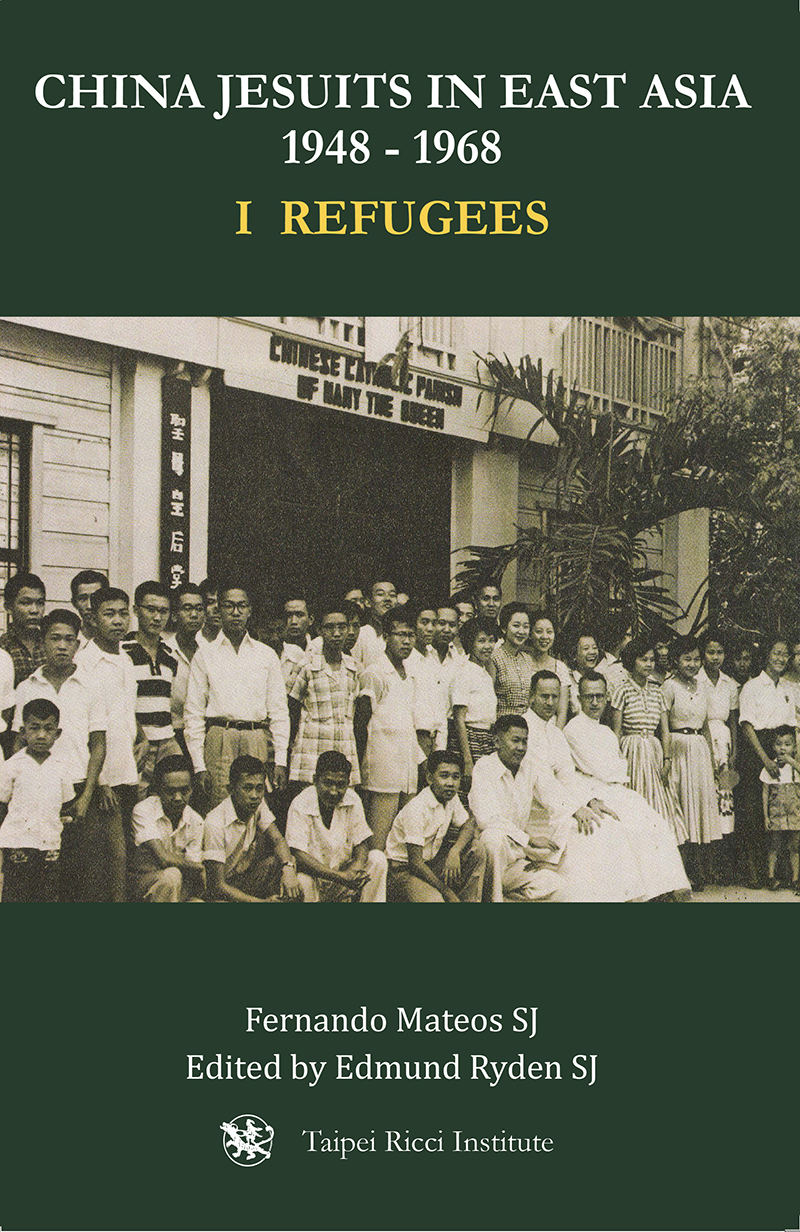
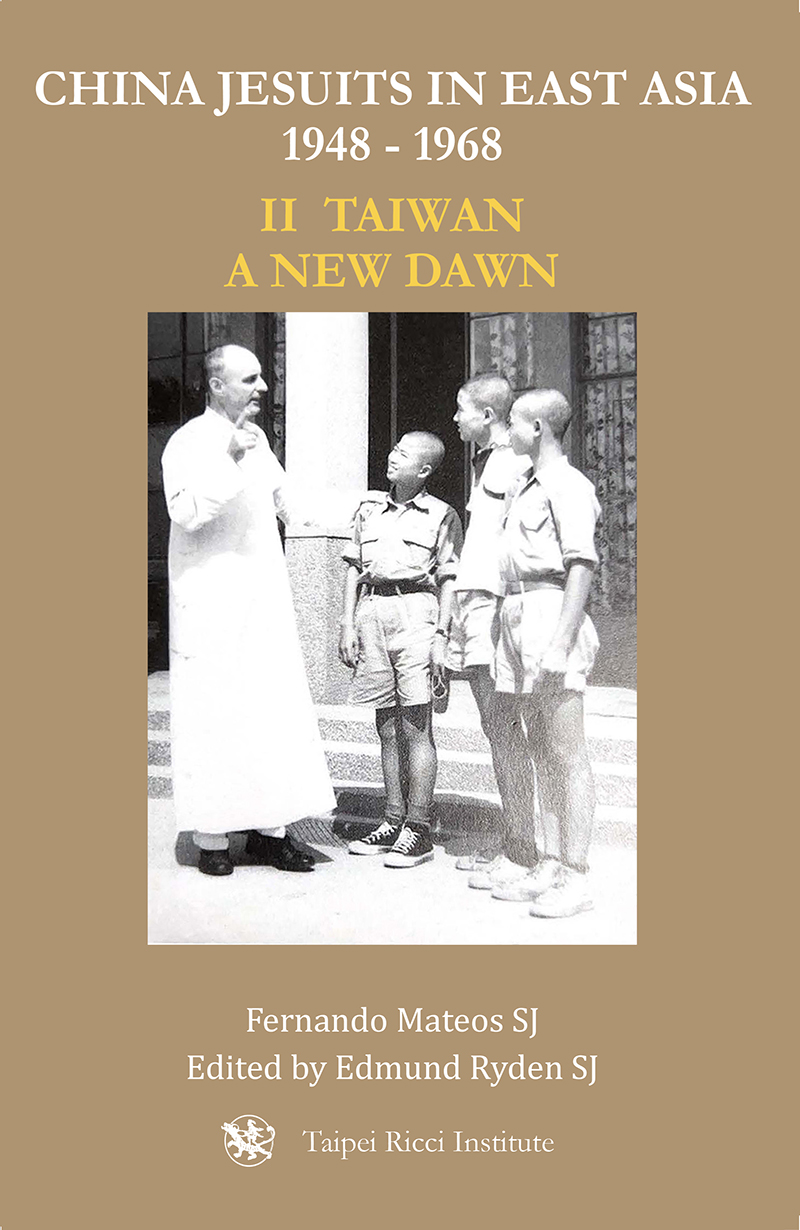
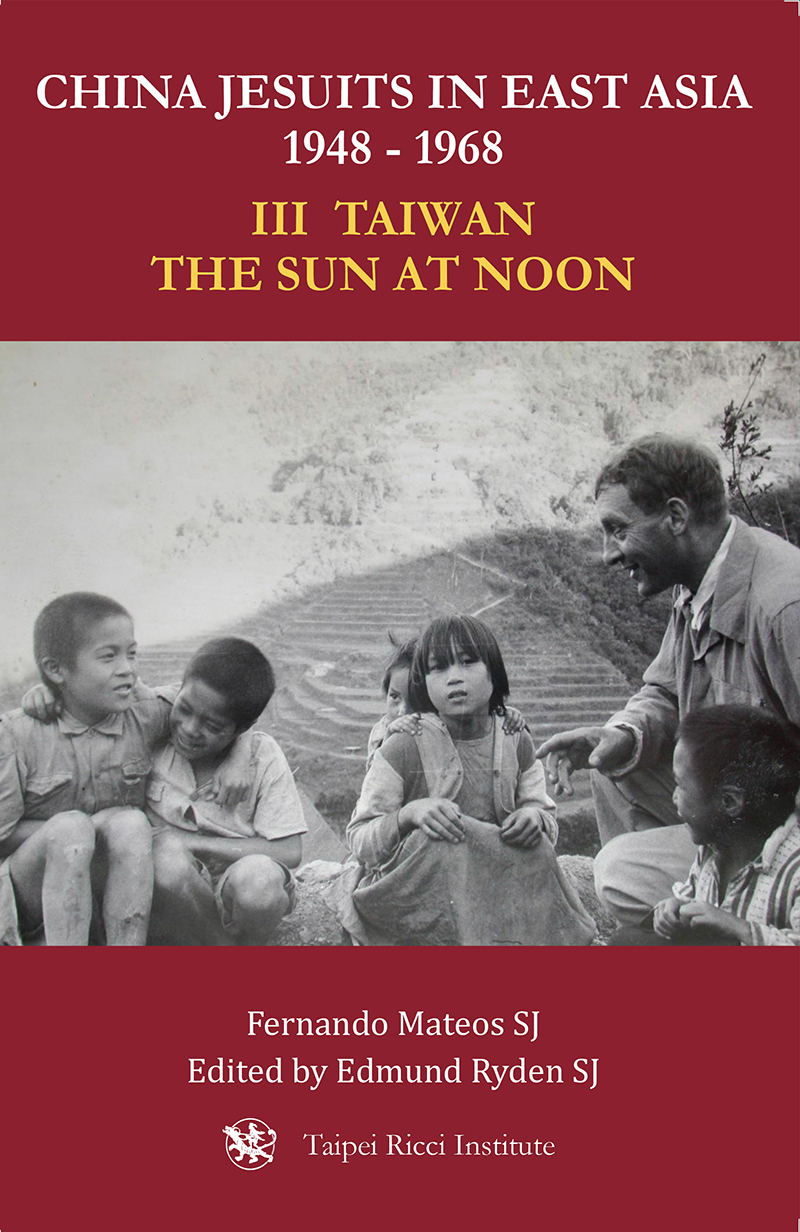

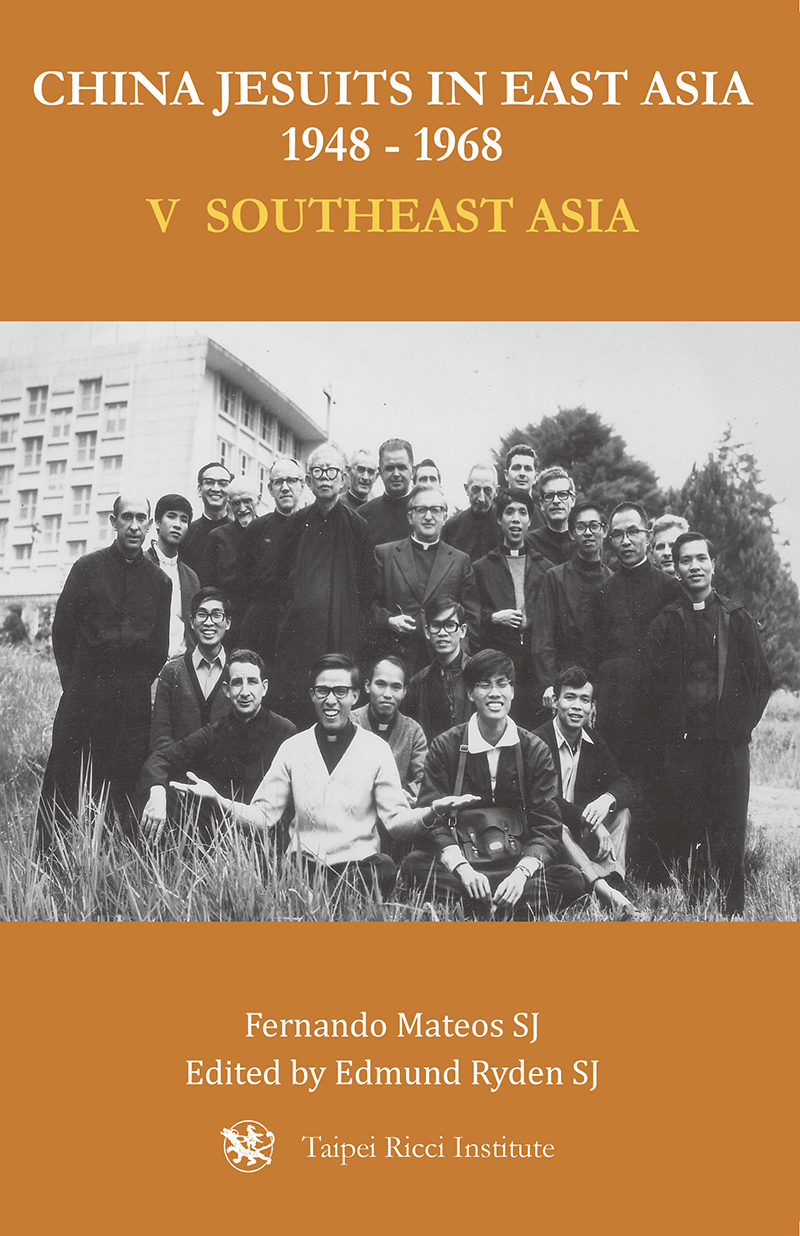
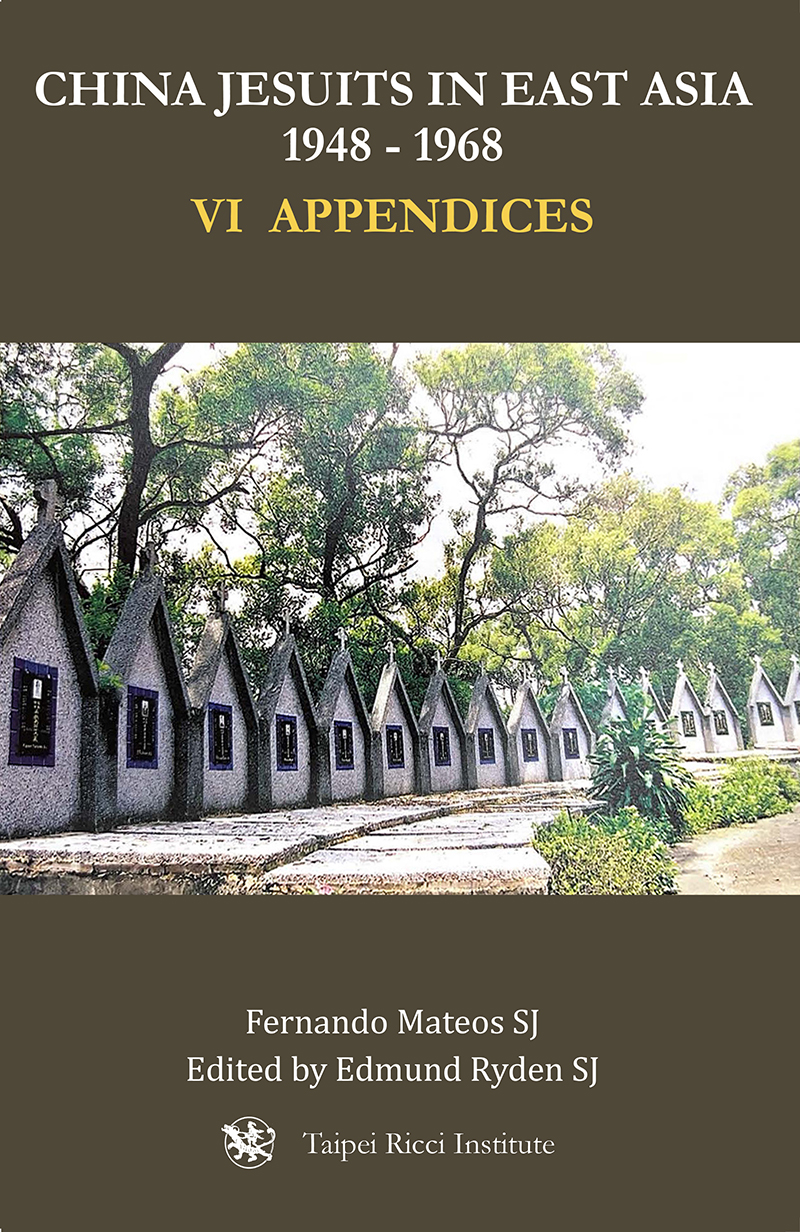
Foreword to China Jesuits in East Asia
Fr Mateos’ original history China Jesuits in East-Asia was divided into two volumes: Starting from Zero 1949-1957 published in 1995 and A Decade of Changes 1958-1967 completed in 1997. Initially the Taipei Ricci Institute decided to prepare the second volume for publication. However, it became clear very soon that the second volume required the first and hence it would be better to reformat both volumes. For the most part Volumes One and Two of the present six volumes include the material from Starting from Zero, whilst Volumes 3, 4 and 5 contain that from A Decade of Changes. Volume Six contains the indices and appendices and the biographical notices that appeared in both original volumes.
The exception to this rearrangement lies in the way the different regions are dealt with. Since both Hong Kong and Macao figure more in Starting from Zero, all the information about these two places has been moved to Volume One, with Chapter 3 devoted to Hong Kong and Chapters 4-5 to Macao. Material dealing with the new missions assigned to the exiled Jesuits has been collected in Volume Five since the original format often cut a story in two according to the 1957/8 watershed.
The result is that Volume One now deals with the departure from China proper, temporary stays in Hong Kong and Macao (as well as the later ongoing missions there) and the temporary stay in the Philippines. Volume Two begins the story of Taiwan, which continues in the following two volumes. Volume Five deals with missions in southeast Asia.
Language: English
Softcover: Volume 1-6, 1,475 pages
ISBN: 978-626-98785-5-5
|
□USA & Canada |
□Europe |
□Asia & Oceania |
□Taiwan |
|
|
Price |
90 USD |
85 Euro |
90 USD |
2,500 NTD |
|
Postage fee |
30 USD |
25 Euro |
25 USD |
80 NTD |
|
Total |
120 USD |
110 Euro |
115 USD |
2,580 NTD |
Books are sent by registered airmail upon receiving your payment.
For Overseas orders, we only accept payment via PayPal.
Please contact: This email address is being protected from spambots. You need JavaScript enabled to view it.
Preface to The Short-lived Catholic Central Bureau by Prof. Chen Fang-chung
Restructuring the Face of the Catholic Central Bureau
Preface to The Short-lived Catholic Central Bureau: National Catalyst for Cultural Apostolate in China (1947-1951)
Chen Fang-chung
Professor of History, Dean of the Faculty of Arts, Fu Jen Catholic University
A chronological glance at the history of Catholicism in China reveals a great paucity of research on the period closest to our present day, post-1949, mostly because of barriers that made religious issues, including their history, a taboo topic under the rule of the Chinese Communist Party. Access to internal Party historical material remains a restraint on researchers in constructing an accurate narrative. It is also difficult to publish articles under both official censorship and the self-censorship of Chinese journals. This situation has worsened in recent years, because the Beijing government has tightened its grip on Christianity.
In addition, the history of Chinese Catholicism is a difficult subject of study. Although there were not many Catholic converts, amounting to only around four million up to 1949, a large number of missionary congregations set foot in China. These religious orders or missionary societies came from European countries and northern America, and their archival documents are in their own languages and stored in their own archives. Their languages include English, Italian, French, Spanish, Portuguese, German and Latin, the lingua franca of the Catholic Church. It was often the language of choice for documents and correspondence. Therefore, researchers must master at least one second language to effectively research even one small area or short period. Moreover, the archives of these religious orders and congregations or ecclesiastical communities are not always accessible. The gradual weakening and decline of the modern church, its past connection with imperialist colonial activities, or the missionary congregations’ own reluctance to expose historical facts that could bring themselves into disrepute entice the gatekeepers of these archives towards caution in allowing access to treasure-hunting researchers.
Under such difficult circumstances, Miss Bibiana Wong came to Taiwan from Hong Kong to study in the doctoral programme of Religious Studies at Fu Jen Catholic University. With great diligence and conscientiousness, she spent six years completing this work, The Short-lived Catholic Central Bureau: National Catalyst for Cultural Apostolate in China (1947-1951). The establishment of the CCB in post-war China was quite an innovative initiative with two specific points worthy of note. Firstly, it was a national body directed by the Apostolic Internuncio with significance to the on-going effort of the Holy See to transform the self-centeredness of European and American missions into something more consistent with the values of the universal church. Secondly, it brought together elite personnel from various religious congregations and missionary societies, as well as native diocesan clergy, becoming a center of cooperation between Chinese and foreign priests. This signified a complete reversal of the trend among the clergy separating Chinese and foreign members in the process of indigenizing the Catholic Church in China, as after all, it is ideal that the clergy should not be divided by nationality.
Dr. Wong’s position on the Catholic Central Bureau is clear: it is a cultural organization of the church. Why was there a need for such an institution in the Chinese Catholic Church? It was related to the nature of the church in China, which, since the fall of the Qing Dynasty, had put the bulk of its energy and resources into expansionist missionary activity to the neglect of apostolates concerning local culture. The church had little positive interaction with mainstream society and mostly found its abode on its fringes. New converts were mostly found among the socially disadvantaged. Society had little knowledge about the church, to the extent that it arrived at extremely awkward misunderstandings. Theories of anarchism and communism seeping into Chinese society in the early Republican years represented yet another dynamic militating against Christianity, as the Catholic Church had difficulty separating itself from imperialism and some Catholics even held feelings of complacency over their elevated status. If these abnormal and irrational trends continued, any attempt on behalf of the church to make itself acceptable to a pluralistic society would have become an unattainable illusion. To reverse this undesirable state, the church needed an educated laity with a more sophisticated understanding of the relationship between religion and culture in order for Catholicism to make any cultural impact of significance on local society. This in turn demanded a radically revised approach to its evangelization methods. The laity would need to be organized in a systematic outreach towards their own small social circles and be courageous in their encounter with mainstream society. However, the chosen method was the Legion of Mary, which differed subtly from the more traditional Catholic Action, an association with a strong lay leadership structure that had existed since the early twentieth century. Its primacy was replaced after the war by the Legion of Mary, which while lay by its nature, is very much a priest-led association.
The CCB attempted to reform the church in its own way, and involve itself in a dialogue with mainstream society. It did not dabble in politics and was purely an ecclesiastical organization. Nevertheless, it was strongly suppressed by the Chinese Communist authorities, mainly because of misunderstandings and the long-standing confrontation between the two entities. The Communist Party considered Catholicism to be a European and American imperialist movement involved in aggression against the Chinese state. While such a perception was not entirely accurate, it was not unreasonable either. However, the perception that the Legion of Mary was a kind of quasi-militarized organization seeking to confront the Chinese Communist Party was over exaggeration. As mentioned above, the CCB was not a political organization. The Catholic Church’s basic opposition to the Communist Party sprang from its atheistic position and the consistent persecution of local Catholic missions it had conducted across China since 1945, when it began to clamp a firm control on the country. Therefore, from a party point of view, a centralized body aimed at uniting the splintered mission effort and representing the universal church in China had to be crushed as a matter of necessity. Consequently, as the party was preparing to take control of the Chinese Catholic Church, it cooked up charges against it. These intentional or unintentional accusations against the CCB, which have been repeatedly fabricated by the Communist propaganda apparatus, have now become a historical source for researchers and form the basis for Chinese and foreign researchers’ own accounts. Dr. Wong’s book is a valuable contribution to dispelling these myths and avoiding an accumulation of falsehood.
Between 2016 and 2019, Dr. Wong has collected data from various archives around the world, sometimes by taking the opportunity of attending conferences, sometimes by applying for grants from research institutes, and sometimes even by spending her own hard-earned savings. Most of these archives opened their doors to her because she is a baptized Catholic and because of her sensitivity and responsiveness accumulated through her journalistic background. When she traveled to the United States to search for information, she visited the Maryknoll Mission Archives, as well as the archdiocesan archives of New York and of Cincinnati. On two occasions she visited the archives of missionary societies in Leuven and Brussels to read material and take photographs after she presented a paper at a conference in Leuven, Belgium, and while a visiting researcher at the Monumenta Serica of the Society of the Divine Word in Sankt Augustin, Germany. To find out about the Society of St. Columban’s involvement in the CCB, she went to its Central Archive in Ireland and was told by the archivist that no one had ever opened the dossiers she was looking at. Of course, she would not have overlooked the Jesuit archives in Taipei or the diocesan archives in Hong Kong. In 2019, she went to Shanghai, China, to collect data from the Shanghai Municipal Archives, where a limited amount of material concerning the Catholic Church after 1949 had been opened to researchers. Her doctoral dissertation was written with the backing of these sources and will definitely catch the eye of experts and general readers alike. In my opinion, it is the first masterpiece among any recent research on the history of Chinese Catholicism.
The book is highly readable. Through Dr. Wong’s lively descriptions, readers can comprehend the efforts of the Chinese Catholic Church at that time, and the remarkable deeds of some clergymen. On the other hand, we can see the limits of the church and its participants, as well as its structural inadequacies. Perhaps readers will share my own regret: the Chinese Communist Party has misunderstood Catholicism, and has indeed overestimated the gambit within which the Catholic Central Bureau operated.
The Short-lived Catholic Central Bureau:
National Catalyst for Cultural Apostolate in China (1947-1951)
曇花一現:天主教教務協進委員會與中國文化傳教事業(1947-1951)
作者:Bibiana Yee-ying WONG 黃懿縈
Hardcover: 335 pages Language: English ISBN: 978-957-29848-7-1
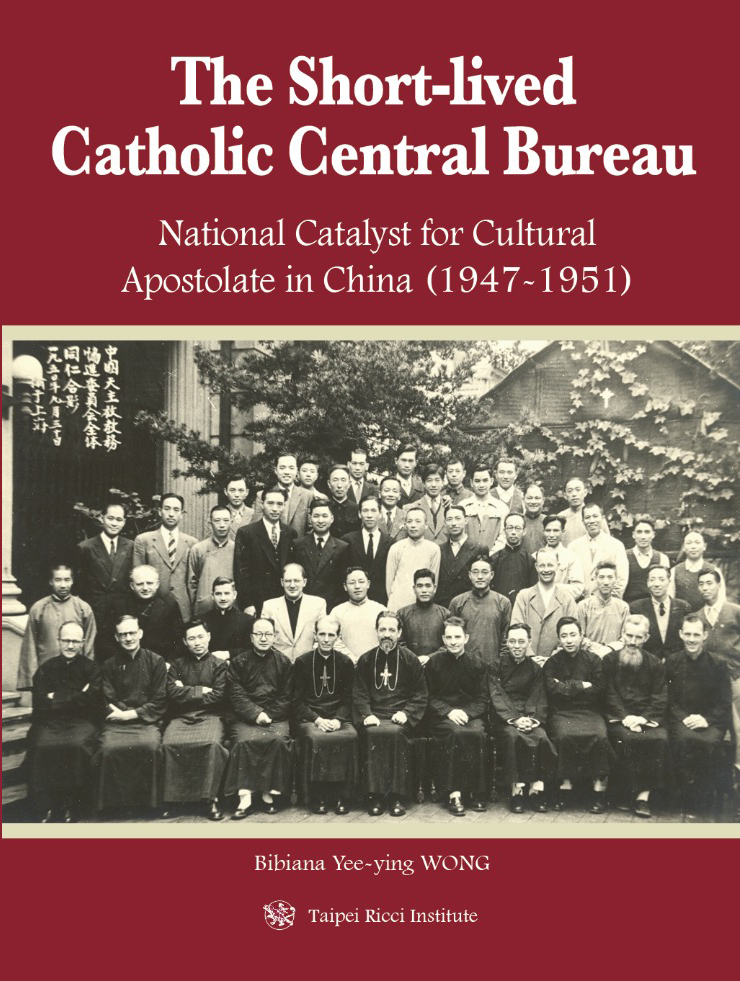
利氏學社出版品 《詮釋三角:漢學、比較經學與跨文化神學的形成與互動》
詮釋三角
漢學、比較經學與跨文化神學的形成與互動
[法]魏明德 (B. VERMANDER) 著
謝華、沈秀臻、魯進、陳文飛 譯
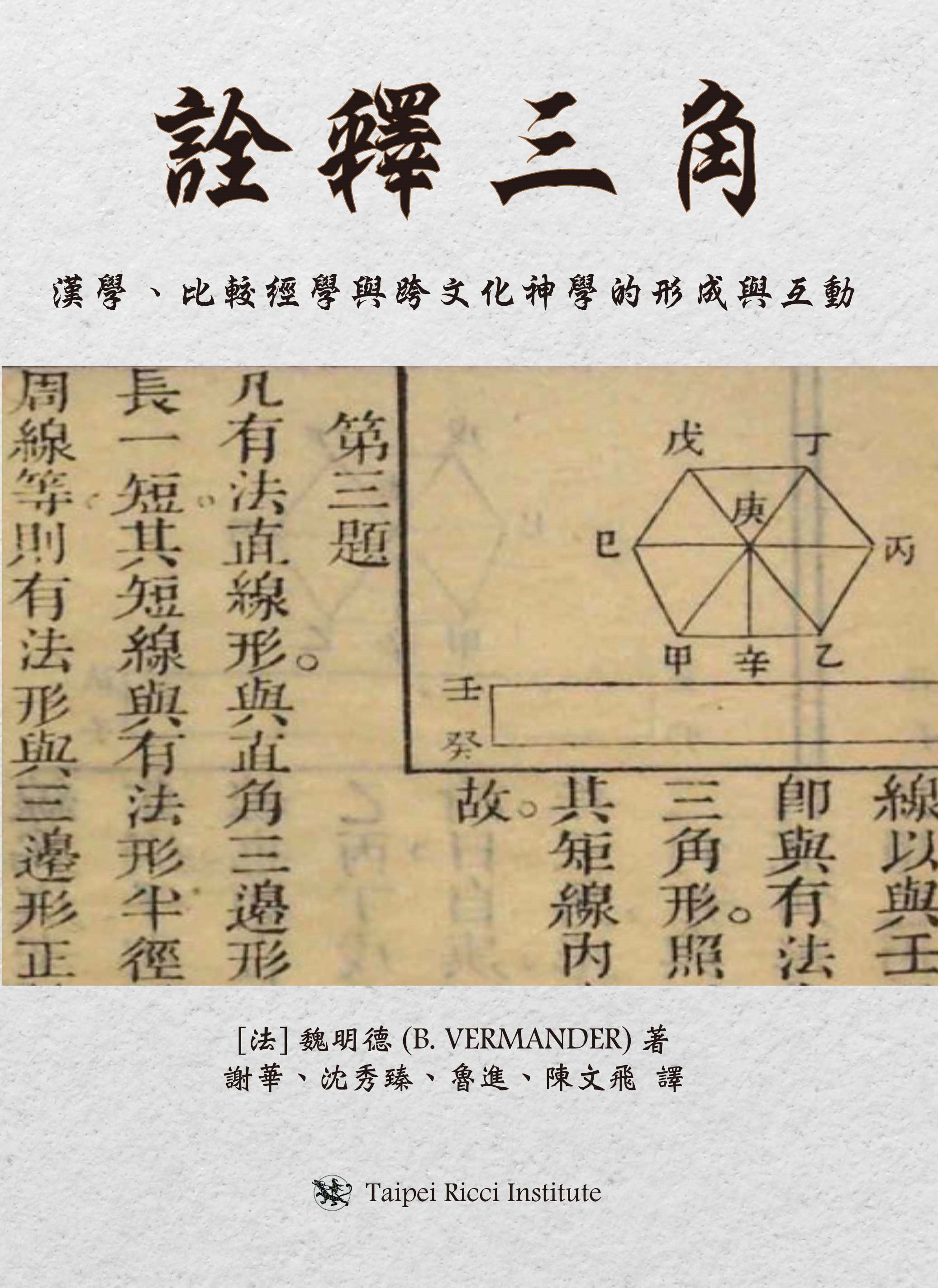
ISBN:978-957-29848-8-8 精裝.中文:367頁
「詮釋三角」:透過這一隱喻,本書研究相互接觸、相互詮釋的三極——漢學、比較經學與跨文化神學——從一體性中分化出來並各自取得獨立建構的過程。如果「比較經學」位居中流,那麼它的上游是「漢學」,下游則是「比較神學」。誠然,這三者之間的聯繫要複雜得多,但在此過程中,它們從未停止彼此之間的相遇、碰撞與回應。對這三種學術工作相交的歷史進行反思,從其共同源頭再次出發,這趟旅途或將賦予我們新的方式,去構想和創造今天宗教與文明之間的關係。
In its First Part (chapters 1 to 5), this book offers an interpretation of the way 16th-18th centuries Jesuits followed by the first generations of Sinologists dealt with Chinese Classics in their efforts to build a body of knowledge about China, on the one hand, and a theological outlook consistent with their evolving understanding of the country’s thought and history, on the other.
The Second Part (chapters 6 to 10) reflects upon this long episode of intellectual history in the light of (a) the Gadamerian reading of the Classics, (b) changes and permanence observed in the Chinese religious landscape, and finally, (c) the issues raised by the nascent field of “Comparative Theology” in Asian context.
作者序
本書的問世經歷了長期的工作,跨越了筆者所關注的多個研究領域。首先,我雖非歷史學家,但一直關注著耶穌會在中國的歷史,並撰寫了多篇相關論文。在這個領域中的收穫,對我從事的跨文化對話的哲學研究具有決定性的意義。同時我也非常關心,當代詮釋學如何能為我們對中國經典的閱讀帶來更新。最後,我的研究以及與許多人的直接交流使我深信,最富創造性的亞洲神學家們正在創造一種神學風格,它扎根於對歷史和文本的反思,激發不同學科、不同宗教或不同民族文化之間進行對話;這樣的對話誠然充滿困難,但卻必不可少,並將結出豐碩的果實。
我有幸受李天綱教授之邀,參與他受國家社科基金支持的「比較經學與宗教間對話」,這使我能夠把上述不同思路在同一個問題意識之下統一起來。我與李天綱教授也多次圍繞此項目進行討論,使這一問題意識不斷得到發展。在這趟學術征程上,我深深感謝李天綱教授的推動和一路的陪伴。
我也向與我合作多年、本書的各位譯者致以特別的謝意。陳文飛翻譯了第二章至第五章的初稿。此後,我向這兩章增補了許多內容,並由沈秀臻進行翻譯和審訂。沈秀臻同樣翻譯了第一章和第八章的部分內容。魯進翻譯了第九章。謝華翻譯了其餘部分,並對全書進行統稿。沒有她的能力與耐心,這本書將不可能面世。不過,應由我本人對最終的成書負責,因為我與每一位譯者都進行過商討,並通讀了全書的譯稿。最後,特別感謝臺北利氏學社的慷慨幫助與編輯郭欣盈耐心細致的工作,使得本書終能付梓。
因其跨學科的性質,本書的工作也承擔著風險。在論及歷史的部分,我必須回顧一些歷史學家所熟知的事實,因為它們對那些主要關注詮釋學或神學的人來說並非常識。本書第二部分則恰好相反。我或許可以進一步展開對當代亞洲神學的一些見解,但我更願意僅僅選擇那些與漢學和比較經學直接相關的因素進行討論。我在緒論與導言中對這些必要的選擇作了說明,也解釋了「詮釋三角」(triangle herméneutique)這一可能令人感到驚奇的表達,具有什麼意義。可以指出的是,我並非想要單純傳遞一些「資訊」,而是意圖捍衛一個論題;因此,對某些看似基礎性的知識,例如利瑪竇對其傳教方法的構想,或者伽達默爾在《真理與方法》中辯護的論題,本書也不吝筆墨,以期能為我們的詮釋之路設立路標。
雖然筆者在中國生活與教學已久,但這本書仍然帶著歐洲視角的烙印。它是在與中國學者和與中國著作的持續對話中完成的,但我的特別興趣所在,以及我展開的某些論題,仍然帶著我本人的特點,並且可能會激起一些論爭。不過這可以說正是我所期待的:願本書得到充分討論和批評,也願在討論與批評的遊戲中,讀者能透過自己的解釋,把本書變成他們自己的文本,使之成為他們反思與靈感的源泉。
復旦大學,二○二○年五月
目錄
緒論
導言:漢學、經學與神學的三角測量
一、耶穌會、中國經典、詮釋學
二、經典與「他者」
三、不斷展開的相遇
四、儒家基督徒與歐洲經院教學
五、閱讀經典:策略和對話
六、漢學的世俗化與《聖經》的中國化
第一部分 耶穌會、漢學與比較經學的形成
第一章 漢學的產生、發展與挑戰
一、漢學知識領域的形成
二、耶穌會士與中國:漢學的開端
三、今日西方漢學:一門過時的學科?
四、漢學對當代中國有何裨益?
第二章 地圖與地盤
一、利瑪竇:備受尊重的人物,備受爭論的傳教策略
二、譯名之爭與龍華民的論著
三、經書和註解
四、從龍華民到萊布尼茲:中國人的自然神學
五、認識論上的問題
第三章 傳教士的福傳使命與漢學考察
一、語言與思想
二、星象與火炮
三、十八世紀在華耶穌會士概觀
四、《耶穌會士書簡集》與杜赫德的《中華帝國全志》
五、大學漢學教育之開端
六、錢德明和耶穌會在華第一次傳教的結束
第四章 耶穌會第二次在華傳教(1842-1949)
一、中國傳教疆域
江南:教會的保護區
河北:災難與動亂
二、耶穌會重啟漢學研究
三、法國《研究》雜誌與中國
四、德日進在中國的非凡遊歷
五、耶穌會第二次在華傳教之後的簡述
第五章 比較性展望:學術漢學的發展
一、法國的學術漢學
葛蘭言:對中國經典的社會學解讀
二、探險與漢學
三、英國漢學、中國經書以及《聖經》
李約瑟和科學史
四、漢學在西歐其他國家
五、早期俄羅斯漢學
六、早期漢學的國際網絡
七、漢學在美國
費正清與區域研究的發展
從區域研究到個案研究
第二部分 從現代比較經學到當代跨文化神學
第六章 詮釋學與比較經學的未來
一、詮釋學:方法與挑戰
二、什麼是經典?
三、什麼是跨文化詮釋學?
四、詮釋學與神學
五、開放的結論
第七章 如何閱讀中國經典?
一、中國的「正典」與「經典」
(一)正典的演變
(二)文本大陸的地形學
二、六種閱讀模式
(一)根據一種既定「策略」
(二)「依照文本自身所給予的」
(三)形式批判與來源批判的方法
(四)透過注經者而閱讀
(五)結構修辭學的考慮
(六)經驗性的閱讀模式
第八章 宗教對話與亞洲語境
一、基督宗教的視角與東南亞的相遇
二、東北亞與詮釋的關注
三、超越宗教復興運動
四、邁向一種泛亞洲的和諧神學
第九章 智慧與啟示的相遇
一、基督宗教傳統中智慧與啟示的關係
二、智慧或「共同的空氣」
三、啟示與詮釋
四、智慧的中國形態
關於智慧與啟示的語匯
「孝心」與「赤子之心」
五、創造一種語言
六、智慧的流動性與啟示的開放性
第十章 跨文化神學的「應無所住」
一、作為遷徙的神學
二、神學朝向虛擬領域的遷徙
三、作為本地神學的跨文化神學
四、跨文化神學中心的歷史經驗
結語
參考文獻
中文
外文
《曇花一現:天主教教務協進委員會與中國文化傳教事業(1947-1951)》陳方中教授推薦序
重建天主教教務協進會的面貌
《曇花一現:天主教教務協進委員會與中國文化傳教事業(1947-1951)》之序言
陳方中
輔仁大學歷史學系教授兼文學院院長
將中國天主教歷史,按時間分段,最靠近現在的1949年以後的時段,反而是研究成果最少的。原因無他,這個時段在中共的控制下,宗教問題包括宗教史,多少是帶有禁忌的研究範疇。研究者很難看到中共內部的史料,無法建立準確的歷史敘述,寫成的文章也很難在中國的審查制度,或是在中國期刊的自我審查意識下發表。這種情況在最近這幾年愈益嚴重,這是因為中國政府對基督宗教的看管愈益嚴密的結果。
其次,中國天主教的歷史很難研究。天主教在中國其實信仰者並不多,到1949年差不多400萬教友,但傳教的團體很多。這些修會或傳教團體來自於歐美各國,他們的檔案以他們自己的語言,保存在他們自己的檔案室內。這些語言包括英、義、法、西、葡、德,而且拉丁文作為教會內的通行語,也三不五時會在文件及信件中出現,研究者至少要有第二外語的能力,才能應付一個小範圍或小時段的研究。這些修會或教會團體的檔案室,也不是想去就可以去的地方,現代教會逐漸弱化及衰退的情勢,或是過去與帝國主義殖民行動的關聯性,或是不願使團體蒙羞的史實出土的心理,都會使得這些檔案室的守門人內心帶著問號,仔細評估想前來挖寶的研究者。
在這樣困難的情況下,黃懿縈小姐從香港來到臺灣,就讀輔仁大學宗教研究所博士班,在相當勤奮認真的情況下,花了六年時間完成這本《曇花一現:天主教教務協進委員會與中國文化傳教事業(1947-1951)》。「天主教教務協進會」是一個很值得探討的主題,當時在中國成立這個組織是相當創新的做法,有兩個重點值得注意:一是它是由教廷駐華公使主導的全國性團體,打破了天主教體系中各教區自行運作的模式,這代表了羅馬教廷持續扭轉歐美各傳教團體自我中心的努力,期望朝向名符其實的普世性教會。第二個重點是這個機構結合了各修會、傳教團體及本地教區神職的菁英,是一個中外司鐸合作的地方。這同樣也是扭轉在中國教會本地化的過程裡中外分途的努力,畢竟這些神職人員在理想的狀態下,應該是不分國籍的。
黃博士對天主教教務協進會的定位很清楚,這是一個教會內的文化性團體。為何在中國天主教會中需要一個這樣的團體?這與中國天主教的體質有關,自清末以來,中國天主教就是一個重傳教但輕文化的團體,教會與本地主流社會缺乏足夠的良性互動,教會處於社會的邊緣,新的望教者多半是社會中的弱勢,主流社會對於教會缺乏足夠的瞭解,甚至是形成了奇怪的誤解。民國初年傳入中國的無政府主義及共產主義對基督宗教形成另一股不友善的力量,天主教又很難將自己與帝國主義劃清界線,甚至部分教友也對自己的特殊身分沾沾自喜。這些都是不正常、不合理的現象,長此以往,想在一個多元社會中建立被接納的教會,將成為不可及的幻想。要扭轉這種不正常的教會狀態,必須教育教友,提升教友的文化程度;必須以新的傳播方式向社會介紹天主教文化;必須組織教友,走出自己的小圈圈,與主流社會勇敢接觸。在這中間有一些做法上的微妙差別,其實從二十世紀初就有「公教進行會」的教友組織,但這時期則以「聖母軍」取而代之。差別在於公教進行會教友的主導性較強,聖母軍則是司鐸領導的教友組織。
這個從教會立場改善自己,嘗試與主流社會對話,不牽涉政治,屬於教會內的組織,卻遭到中共當局的強力打壓,原因主要是誤解和過去雙方長時間的對立。中共認為天主教是歐美帝國主義侵略中國的一環,這樣的認知不完全準確,但也不無道理。但是將聖母軍視為一種天主教對抗中共的類軍事化組織,則是言過其實,前已提及天主教教務協進會並不是政治性的組織。從教會這一邊,因為共產黨的無神論立場,也因為1945年以來中共獲得區域性控制後,經常性清算當地教會的作為,基本上她是反對共產黨的。因此一個凝聚教會的中央化的、代表普世教會的機構,當中共準備自己控制中國天主教時,當然必須要將其瓦解,也必須要在其上安排一些罪證。這些有意無意對天主教教務協進會的指控,在中共宣傳機器的反覆炮製下,現在已經成了研究者的史料,形成了中外研究者各說各話的一方依據。黃博士的這本書正在打破其中的迷思,避免積非成是。
在2016年至2019年間,黃博士有時是藉由開會的機會,有時是申請研究單位的補助,有時甚至是花自己辛苦節省的錢,到世界各處的檔案館蒐集資料。因為她天主教徒的身分,也因為她過去記者訓練的機敏與應對進退,這些檔案館多半都為她打開了大門。在她去美國搜尋資料時,去了在紐約的瑪利諾會檔案館,也順便去了紐約總教區檔案館、辛辛那提總教區檔案館。到比利時魯汶參加會議時,以及在德國聖奧古斯丁聖言會的華裔學志研究所作研究訪問時,她兩度到魯汶及布魯塞爾的教會檔案館閱讀及拍照。為了瞭解聖高隆邦會對天主教教務協進會的參與,她到了愛爾蘭的修會檔案室,管理人告訴她,她要看的資料匣從來沒人打開過。當然她不會放過臺北耶穌會的檔案室、香港教區檔案處。她在2019年也去了中國上海,在有限度開放1949年後的天主教資料的上海市檔案館蒐集資料。她的博士論文是在這些資料的背書下寫成的,絕對能令專家及一般讀者都眼睛為之一亮。在我個人看來,這是最近中國天主教歷史的第一名傑作。
這本書的可讀性是相當高的,我們讀者可以藉由黃博士生動的描述,瞭解當時中國天主教的努力,一些神職人員可歌可泣的事蹟。另一方面,我們也能看到當時教會及其中參與者的限度,看到結構性的不健全。或許讀者會因此產生和我一樣的慨歎:中共真是誤解了天主教;中共真是高估了天主教教務協進會。
The Short-lived Catholic Central Bureau:
National Catalyst for Cultural Apostolate in China (1947-1951)
曇花一現:天主教教務協進委員會與中國文化傳教事業(1947-1951)
作者:Bibiana Yee-ying WONG 黃懿縈
Hardcover: 335 pages Language: English ISBN: 978-957-29848-7-1

利氏學社出版品 《曇花一現:天主教教務協進委員會與中國文化傳教事業(1947-1951)》
The Short-lived Catholic Central Bureau:
National Catalyst for Cultural Apostolate in China (1947-1951)
曇花一現:天主教教務協進委員會與中國文化傳教事業(1947-1951)
作者:Bibiana Yee-ying WONG 黃懿縈
Hardcover: 335 pages Language: English ISBN: 978-957-29848-7-1

本書是研究在戰後中國成立的上海天主教教務協進委員會的首部專著。時值教廷在中國建立教會聖統制,並與國民黨政府展開正式外交關係,教務協進會在教廷駐華公使指導下,集合不同傳教修會的中外籍神職菁英,除了協調近140個教區的傳教活動,特別著重於文化傳教事業,運用現代媒體向城市知識分子傳播基督信仰的價值觀,抗衡唯物論者的反宗教宣傳。它又向全國推廣聖母軍,培育平信徒協助文化傳教,為使一旦神職人員無法履行牧職,天主教團體依然保持活力。最終,教務協進會在中共建國初年被取締,各項計劃未能實現,主要成員遭逮捕、驅逐或在拘禁期間殞命。儘管上海教務協進會鮮明的歷史角色結束,它卻在台北和新加坡開枝散葉,協調全球華人傳教工作,本書的敘述延伸至這兩個鮮少有人研究的機構。
This book may be called a groundbreaking work of research into the historical event of the Shanghai Catholic Central Bureau (CCB), which was an ecclesiastical executive organ set up by the Apostolic Internuncio after the establishment of Sino-Vatican diplomatic relations and the Catholic Hierarchy in post-war China. Besides coordinating missionary activities of nearly 140 dioceses administered by various religious congregations, it promoted a cultural apostolate with the use of modern communication media to guide people in the understanding of the Catholic faith and advise missionary work in the face of anti-religious propaganda by materialists. It also trained the laity through the Legion of Mary to sustain Catholic communities when the clergy was barred from its ministries. Eventually, the CCB could not establish its endeavor due to the Communist ban. Key members of the Bureau were arrested, expelled or died early in prison. Despite its vivid historical role of the CCB in Shanghai, this book also investigates its two “heirs” in Taipei and Singapore to organize the apostolate to the Chinese in diaspora.
關鍵詞:中國天主教、共產主義與基督宗教、聖母軍、政教關係、三自運動
Keywords: Chinese Catholicism, communism and Christianity, Legion of Mary, state-church relations, Three-Self Movement
陳方中教授推薦序,請按此閱讀
Preface by Prof. Chen Fang-chung, click here to read
About the Author
Bibiana Yee-Ying Wong is a postdoctoral fellow at the Institute of Modern History, Academia Sinica in Taiwan. She received her Ph.D. in Religious Studies from Fu Jen Catholic University in 2020. Her research interest is in the history of Chinese Catholicism in the twentieth century. While working as a journalist for two Catholic news organizations in Hong Kong from 2002 to 2013, she obtained Master’s degrees in Journalism and in Religious Studies from the Chinese University of Hong Kong.
黃懿縈是土生土長的香港人,台灣天主教輔仁大學宗教學博士(2020),中央研究院近代史研究所博士後研究學者(2021-2022),研究方向為二十世紀中國天主教歷史與政教關係。曾任職於香港兩間天主教新聞機構(2002-2013),並修畢香港中文大學的新聞學及宗教研究碩士學位。
Table of Contents
Introduction
1 A Zigzag Path to Uniformity
– Historical overview of missionary cooperation before the CCB –
Regional synods in China during late Qing period
New missionary strategy and directives
Celso Costantini and Primum Concilium Sinense
Synodal Commission on Schools, Books and Press
Catholic Action movement and Mario Zanin
2 “The Dizziest Place” in Shanghai
– Creation and organization of the Catholic Central Bureau–
Establishment of the Chinese Catholic Hierarchy
Reorganization of Synodal Commissions by Antonio Riberi
The Catholic Central Bureau in its initial stage
Christianization of China through cultural apostolate
3 Creative Propagators of the Faith
– Five foreign missionaries in the CCB and their work–
François X. Legrand and publication work
Jan Joos and Catholic radio activities
Jozef Vos, Correspondence Courses and his books
Patrick O’Connor and Hua Ming News Service
Aedan W. McGrath and the Legion of Mary
4 Talented Defenders of the Church
– Five Chinese priests in the CCB and their life’s witness –
Matthew Chen, courageous scholar and writer
Joseph Shen, organizer and martyr of the Legion
John Dong and his apologetic speech
John B. Gao and the national congress on Catholic education
John Mao and his fight for the Overseas Student Service
5 Three-Self Reforms and the CCB
– The origin and course of state-church friction –
Opposition between Catholic and Communist ideologies
Religious policy of Chinese Communists
The Three-Self Reform Movement
The CCB’s three responding documents
6 A Tool of the Imperialist Riberi”
– Ban on the CCB and the Legion of Mary –
The first arrest: François Théry
Suspension of the CCB and press attack
Mass arrest of the CCB directors
Crackdown on the Legion of Mary
Tragic death of Jozef Vos
Imprisonment of McGrath and Legrand
7 Aftermath and Continuation
– The CCB’s final days in Shanghai and reestablishment after 1952 –
The CCB chapel and playground
The fate of Bishop James E. Walsh
Riberi restored the CCB in Taiwan
The Singapore Catholic Central Bureau
Conclusion
Bibliography
Index
